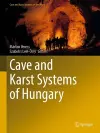
Cave and Karst Systems of Hungary
2 contributors - Hardback
£139.99
Márton Veress completed his university studies at Szeged University, in the fields of biology and geography. He obtained his PhD degree in 1997, his habilitation in 2001 and DsC in 2004. From 1984 he was the lecturer of the West Hungarian University, from 2006 he is a professor. From 1990 he is the head of the Department for Physical Geography. Between 2006 and 2012 he is the director of the Institute for Geography and Environmental Science and the dean of the Faculty for Natural Science. Between 2001 and 2002 he is vice-rector. He is responsible for the course of Geographers BsC and MsC, he is the head of the Doctoral School of Environmental Sciences and he is professor emeritus at ELTE University currently. His research fields are karst morphology within this, karren, covered karsts and modelling of karstic processes. He carried out his field studies mainly in the karst areas of Central Europe, but he also organized research expeditions in other parts of the world, thus in China (1990), Iceland (1997), Chile (2002), Himalayas (2003), Madagascar (2004) and Lena (2012). He is the author of over 200 articles over 30 books and book chapters. He is currently the chief editor of the journal 'Karsztfejlődés'. He is a member of the Editoral Board at various international journals and a Series Advisory Editor of the Springe Geography book series. Most recently he co-authored the book "Glaciokarsts", which was published by Springer in 2019.
Szabolcs Leél-Őssy completed his MSC studies at Eötvös Loránd University (ELTE) in Budapest. He obtained his PhD in 1998. He is a geologist and associate professor at ELTE University. He served as President of the Hungarian Karst and Cave Research Association during 16 years and Associate President of the Hungarian Geological Society during 6 years. He is an expert on karst and cave research in Hungary. (He was one of the leaders of the discovery group of the Józsefhegy Crystal Cave in 1984, and – together with Péter Adamkó – discovered around 30 other, smaller caves in Budapest).
He wrote more than 50 scientific publications and more than 30 books and book chapters. He previously authored two chapters in books published by Springer, in "Landscapes and Landforms of Hungary" (2015) and in "Hypogene Karst Regions and Caves of the World" in 2017.